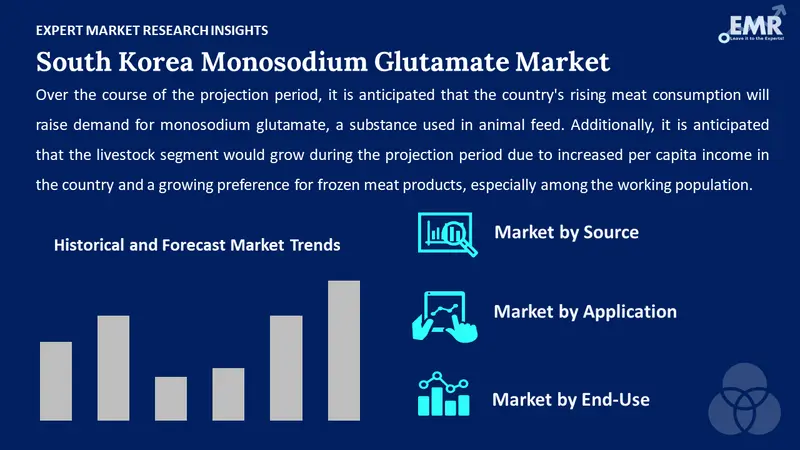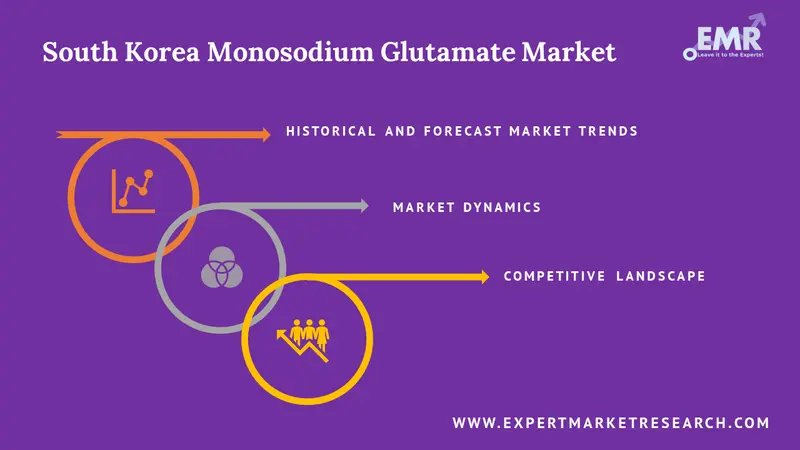
Consumer Insights
Uncover trends and behaviors shaping consumer choices today
Procurement Insights
Optimize your sourcing strategy with key market data
Industry Stats
Stay ahead with the latest trends and market analysis.
The South Korea monosodium glutamate market is expected to grow at a CAGR of 5.10% between 2026 and 2035. The changing perception of consumers is boosting its demand, especially in the food processing and cosmetics industry. The growing demand for processed meats is also driving its demand in the market.
Base Year
Historical Period
Forecast Period
Compound Annual Growth Rate
5.1%
2026-2035
*this image is indicative*
Glutamate is created when maize, bacteria, or sugarcane are broken down and converted into smaller bits. Fish, meats, nuts, tomatoes, mushrooms, seaweed, and the majority of dairy products all contain glutamate, a naturally occurring amino acid that is also present in the human body. The outcome is a white crystal, which is subsequently combined with salt to produce monosodium glutamate or MSG.
Wide Usage of Monosodium Glutamate as a Flavour Enhancer is Boosting its Demand in the Country
In order to make items like cheeses, sauces, meat and dairy products, and baked goods, monosodium glutamate is utilised as a flavour enhancer and in food additives, which is bending the market success curve exponentially. These factors, together with the fact that monosodium glutamate is used to make milk products last longer on the shelf, are what causing the monosodium glutamate market to grow. Monosodium glutamate is highly demanded by food service industries, food processors, and the retail sector for the manufacture and production of packaged meals, instant functional foods, and soups, which is fueling market expansion over the anticipated period.
The Ongoing Research is Improving the Image of Monosodium Glutamate in the Food Industry, which is Bolstering its Market in South Korea
MSG is becoming increasingly popular with the general population owing to the ongoing work of academics and scientists over the past few years. About two decades ago, numerous businesses began promoting the lack of MSG in their products in an effort to project an image of being chemical-free and gain market dominance. This grew the notion that MSG was dangerous. There have been several reports of MSG-related obesity, headaches, or indigestion. MSG is a safe food ingredient, according to the local Food Safety Ministry, which doesn't even include a daily intake recommendation. There are daily intake recommendations for salt and sugar, which are frequently used in cooking.
The High Demand for Processed and Ready-to-Eat Food Items is Leading to the Expansion of the Monosodium Glutamate Industry in South Korea
Due to MSG's extensive use in the production of processed foods, monosodium glutamate volume has skyrocketed. Another significant reason driving both production and demand of MSG is a rise in the consumption of prepared foods and other processed meals. These days, the "Ready-to-eat" and "Ready-to-cook" food industries are open to many huge corporations and new-age producers since customers are time-constrained and want to buy simple, fast and easily available items. In order to generate such pre-cooked ready-to-eat meals and associated possibilities in the Market, key companies have started to enter further into potential prospects of the food industry. They are doing this by fostering innovation, adapting to quality measures, and boosting usability.

Read more about this report - REQUEST FREE SAMPLE COPY IN PDF
The EMR’s report titled “South Korea Monosodium Glutamate Market Report and Forecast 2026-2035” offers a detailed analysis of the market based on the following segments:
Market Breakup by Source
Market Breakup by Application
Market Breakup by End-Use
Based on sources, cheese, tomatoes, sugarcane, or molasses, among others, are all the sources from which MSG is extracted. With increased consumer awareness that monosodium glutamate is not harmful to health, its market has been greatly impacted positively, and to meet the rising demand, all segments are expected to secure a considerable share of the market. The continuous research and development work by researchers and academicians in the field is greatly helping in improving the image and breaking myths regarding monosodium glutamate among the general public.
Over the course of the projection period, it is anticipated that the country's rising meat consumption will raise demand for monosodium glutamate, a substance used in animal feed. Additionally, it is anticipated that the livestock segment would grow during the projection period due to increased per capita income in the country and a growing preference for frozen meat products, especially among the working population. Moreover, factors like the improved and easy accessibility of ready-to-eat and processed food items have greatly increased the market for preservatives, additives, acidity regulators, and flavour enhancer segments, which ultimately proliferate the monosodium glutamate (MSG) market in South Korea.
In the food processing sector, MSG-containing meals are becoming more and more well-liked because consumers believe they are more savoury and appetising than dishes without MSG. This factor has helped this segment secure a significant share of the market.
MSG, often known as monosodium glutamate, is sodium 2-aminopentanedioate. It is essentially the sodium salt of glutamic acid, an amino acid that occurs naturally. The molecular formula for it is C5H8NO4Na. MSG is produced commercially by fermenting a suitable sugar source with the intention of using it as a medicinal excipient. Moreover, MSG is used to treat free glutamic acid that has been released from proteins during the production of many cosmetics and other related goods. MSG has also been used in vaccinations as a stabiliser and preservative to keep vaccines potent over a wide range of temperatures and shelf lives. The demand among these and several other end-users bolsters the market for monosodium glutamate in South Korea.

Read more about this report - REQUEST FREE SAMPLE COPY IN PDF
The comprehensive EMR report provides an in-depth assessment of the market based on the Porter's five forces model along with giving a SWOT analysis. The report gives a detailed analysis of the following key players in the South Korea monosodium glutamate market, covering their competitive landscape and latest developments like mergers, acquisitions, investments and expansion plans.
Producing meals, bioscience fine chemicals, medicines, and health items are the company's main areas of concentration. It conducts research, develops, and produces sauces and seasonings and offers quick-nourishment items such as Knorr cup soup, coffee beverages, bakery, processed, edible oil, frozen, and amino acid products for food and medicines, among others. Additionally, Ajinomoto offers speciality chemicals, functional materials, and biopharma services. Under the brand names amino VITAL, AJI-NO-MOTO, Birdy, HON-DASHI, Cook Do, AjiPro, Knorr, Blendy, Masako, and Glyna, the corporation sells its goods. Its goods are used in the restaurant and catering sectors. The corporation has activities in Africa, the USA, Europe, and Asia-Pacific. The headquarters of Ajinomoto is in Tokyo, Japan.
Since its founding in 1949, COFCO Corporation (COFCO) has dominated China's agricultural and food sectors. It is also one of the largest agri-product merchants globally, with a fully integrated value chain. Agri-products are the centre of COFCO's primary business, with a particular emphasis on grain, oil, sugar, cotton, meat, and dairy products. Three other important auxiliary industries are food, finance, and real estate.
COFCO has RMB 686.0 billion in total assets as of the end of 2021, RMB 664.9 billion in total operating revenue, and RMB 23.8 billion in total profit. On a global scale, COFCO has been proactively developing international markets and enhancing G&O logistics and storage capacity globally to guarantee a reliable international supply chain.
*Please note that this is only a partial list; the complete list of key players is available in the full report. Additionally, the list of key players can be customized to better suit your needs.*
Other key players in the South Korea Monosodium Glutamate Market are CJ CheilJedang Corp, Daesang Corporation, among others.




*While we strive to always give you current and accurate information, the numbers depicted on the website are indicative and may differ from the actual numbers in the main report. At Expert Market Research, we aim to bring you the latest insights and trends in the market. Using our analyses and forecasts, stakeholders can understand the market dynamics, navigate challenges, and capitalize on opportunities to make data-driven strategic decisions.*
Get in touch with us for a customized solution tailored to your unique requirements and save upto 35%!
The monosodium glutamate market is projected to grow at a CAGR of 5.10% between 2026 and 2035.
Increasing demand for flavour enhancers in the food processing industry, rising disposable income, increased consumer awareness, continuous research and development by researchers and academicians, and its application in various industries are the major drivers of the market.
The increasing demand for ready-to-eat and processed food and their improved accessibility is the key trend of the South Korea monosodium glutamate market.
The dominant type of monosodium glutamate in the industry are sugarcane or molasses, tomatoes, and cheese, among others.
The major players in the industry are Ajinomoto Co., Inc, CJ CheilJedang Corp, Daesang Corporation, and COFCO International, among others.
Explore our key highlights of the report and gain a concise overview of key findings, trends, and actionable insights that will empower your strategic decisions.
| REPORT FEATURES | DETAILS |
| Base Year | 2025 |
| Historical Period | 2019-2025 |
| Forecast Period | 2026-2035 |
| Scope of the Report |
Historical and Forecast Trends, Industry Drivers and Constraints, Historical and Forecast Market Analysis by Segment:
|
| Breakup by Source |
|
| Breakup by Application |
|
| Breakup by End-Use |
|
| Market Dynamics |
|
| Competitive Landscape |
|
| Companies Covered |
|
Datasheet
One User
USD 2,499
USD 2,249
tax inclusive*
Single User License
One User
USD 3,999
USD 3,599
tax inclusive*
Five User License
Five User
USD 4,999
USD 4,249
tax inclusive*
Corporate License
Unlimited Users
USD 5,999
USD 5,099
tax inclusive*
*Please note that the prices mentioned below are starting prices for each bundle type. Kindly contact our team for further details.*
Flash Bundle
Small Business Bundle
Growth Bundle
Enterprise Bundle
*Please note that the prices mentioned below are starting prices for each bundle type. Kindly contact our team for further details.*
Flash Bundle
Number of Reports: 3
20%
tax inclusive*
Small Business Bundle
Number of Reports: 5
25%
tax inclusive*
Growth Bundle
Number of Reports: 8
30%
tax inclusive*
Enterprise Bundle
Number of Reports: 10
35%
tax inclusive*
How To Order

Select License Type
Choose the right license for your needs and access rights.

Click on ‘Buy Now’
Add the report to your cart with one click and proceed to register.

Select Mode of Payment
Choose a payment option for a secure checkout. You will be redirected accordingly.
Gain insights to stay ahead and seize opportunities.

Get insights & trends for a competitive edge.

Track prices with detailed trend reports.

Analyse trade data for supply chain insights.

Leverage cost reports for smart savings

Enhance supply chain with partnerships.

Connect For More Information
Our expert team of analysts will offer full support and resolve any queries regarding the report, before and after the purchase.
Our expert team of analysts will offer full support and resolve any queries regarding the report, before and after the purchase.
We employ meticulous research methods, blending advanced analytics and expert insights to deliver accurate, actionable industry intelligence, staying ahead of competitors.
Our skilled analysts offer unparalleled competitive advantage with detailed insights on current and emerging markets, ensuring your strategic edge.
We offer an in-depth yet simplified presentation of industry insights and analysis to meet your specific requirements effectively.
Share